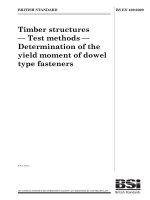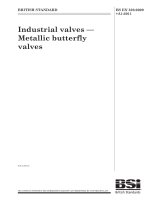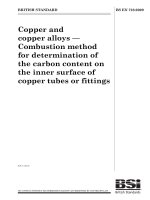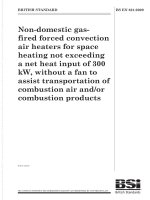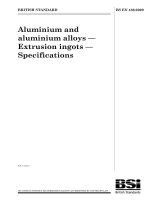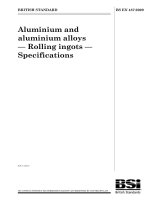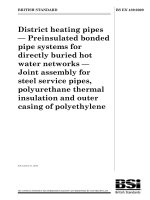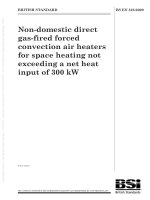Bsi bs en 62430 2009
Bạn đang xem bản rút gọn của tài liệu. Xem và tải ngay bản đầy đủ của tài liệu tại đây (1.77 MB, 32 trang )
BS EN 62430:2009
BSI British Standards
Environmentally conscious
design for electrical and
electronic products
NO COPYING WITHOUT BSI PERMISSION EXCEPT AS PERMITTED BY COPYRIGHT LAW
raising standards worldwide™
BRITISH STANDARD
BS EN 62430:2009
National foreword
This British Standard is the UK implementation of EN 62430:2009. It is
identical to IEC 62430:2009.
The UK participation in its preparation was entrusted to Technical Committee
GEL/111, Electrotechnical environment committee.
A list of organizations represented on this committee can be obtained on
request to its secretary.
This publication does not purport to include all the necessary provisions of a
contract. Users are responsible for its correct application.
© BSI 2009
ISBN 978 0 580 57459 7
ICS 13.020.01; 29.020; 31.020; 43.040.10
Compliance with a British Standard cannot confer immunity from
legal obligations.
This British Standard was published under the authority of the Standards
Policy and Strategy Committee on 31 July 2009
Amendments issued since publication
Amd. No.
Date
Text affected
EUROPEAN STANDARD
EN 62430
BS EN 62430:2009
NORME EUROPÉENNE
EUROPÄISCHE NORM
June 2009
ICS 13.020; 43.040.10
English version
Environmentally conscious design
for electrical and electronic products
(IEC 62430:2009)
Eco-conception pour les produits
électriques et électroniques
(CEI 62430:2009)
Umweltbewusstes Gestalten von
elektrischen und elektronischen Produkten
(IEC 62430:2009)
This European Standard was approved by CENELEC on 2009-05-01. CENELEC members are bound to comply
with the CEN/CENELEC Internal Regulations which stipulate the conditions for giving this European Standard
the status of a national standard without any alteration.
Up-to-date lists and bibliographical references concerning such national standards may be obtained on
application to the Central Secretariat or to any CENELEC member.
This European Standard exists in three official versions (English, French, German). A version in any other
language made by translation under the responsibility of a CENELEC member into its own language and notified
to the Central Secretariat has the same status as the official versions.
CENELEC members are the national electrotechnical committees of Austria, Belgium, Bulgaria, Cyprus, the
Czech Republic, Denmark, Estonia, Finland, France, Germany, Greece, Hungary, Iceland, Ireland, Italy, Latvia,
Lithuania, Luxembourg, Malta, the Netherlands, Norway, Poland, Portugal, Romania, Slovakia, Slovenia, Spain,
Sweden, Switzerland and the United Kingdom.
CENELEC
European Committee for Electrotechnical Standardization
Comité Européen de Normalisation Electrotechnique
Europäisches Komitee für Elektrotechnische Normung
Central Secretariat: Avenue Marnix 17, B - 1000 Brussels
© 2009 CENELEC -
All rights of exploitation in any form and by any means reserved worldwide for CENELEC members.
Ref. No. EN 62430:2009 E
BS EN 62430:2009
EN 62430:2009
-2-
Foreword
The text of document 111/104/CDV, future edition 1 of IEC 62430, prepared by IEC TC 111,
Environmental standardization for electrical and electronic products and systems, was submitted to the
IEC-CENELEC parallel vote and was approved by CENELEC as EN 62430 on 2009-05-01.
The following dates were fixed:
– latest date by which the EN has to be implemented
at national level by publication of an identical
national standard or by endorsement
(dop)
2010-02-01
– latest date by which the national standards conflicting
with the EN have to be withdrawn
(dow)
2012-05-01
__________
Endorsement notice
The text of the International Standard IEC 62430:2009 was approved by CENELEC as a European
Standard without any modification.
In the official version, for Bibliography, the following notes have to be added for the standards indicated:
ISO 9000
NOTE Harmonized as EN ISO 9000:2005 (not modified).
ISO 9001
NOTE Harmonized as EN ISO 9001:2008 (not modified).
ISO 14001
NOTE Harmonized as EN ISO 14001:2004 (not modified).
ISO 14040
NOTE Harmonized as EN ISO 14040:2006 (not modified).
__________
BS EN 62430:2009
–2–
62430 © IEC:2009
CONTENTS
INTRODUCTION.....................................................................................................................5
1
Scope ...............................................................................................................................6
2
Normative references .......................................................................................................6
3
Terms and definitions .......................................................................................................6
4
Fundamentals of environmentally conscious design (ECD) ...............................................8
5
4.1 General ...................................................................................................................8
4.2 Life cycle thinking....................................................................................................8
4.3 Regulatory and stakeholders’ requirements .............................................................9
4.4 Integration into management system .......................................................................9
Environmentally conscious design process (ECD process) ............................................... 9
5.1
5.2
5.3
5.4
5.5
5.6
General ...................................................................................................................9
Analysis of regulatory and stakeholders’ environmental requirements ................... 10
Identification and evaluation of environmental aspects and corresponding
impacts ................................................................................................................. 10
Design and development ....................................................................................... 11
Review and continual improvement ....................................................................... 11
Information sharing for ECD .................................................................................. 11
Annex A (informative) Fundamentals of environmentally conscious design .......................... 13
www.bzfxw.com
Annex B (informative) Elaboration of environmentally conscious design process (ECD
process) ............................................................................................................................... 16
Annex C (informative) Examples categories of tools ............................................................ 26
Bibliography.......................................................................................................................... 29
Figure A.1 – Overview of ECD process ................................................................................. 13
Figure B.1 – Examples of environmental impacts associated with a product’s inputs,
outputs and life cycle stages ................................................................................................. 20
Figure B.2 – Example of the integration of environmental aspects into the design and
development process ............................................................................................................ 24
Figure B.3 – Information sharing and collaboration along the supply chain for ECD
processes ............................................................................................................................. 25
Table B.1 – Examples of procedures for ECD Process .......................................................... 16
Table B.2 – Life cycle stages and examples of environmental aspects for the
identification of the significant life cycle stages and environmental aspects .......................... 21
Table C.1 – Overview of tools which can be used in ECD ..................................................... 26
BS EN 62430:2009
62430 © IEC:2009
–5–
INTRODUCTION
Every product has an effect on the environment, which may occur at any or all stages of its
life cycle – raw-material acquisition, manufacture, distribution, use, maintenance, re-use and
end of life. These effects may range from slight to significant; they may be short-term or longterm; and they may occur at the local, national, regional or global level (or a combination
thereof).
The widespread use of electrical and electronic products has drawn increased awareness to
their environmental impacts. As a result, legislation, as well as market-driven requirements for
environmentally conscious design, are emerging.
The goal of environmentally conscious design is the reduction of adverse environmental
impacts of a product throughout its entire life cycle. This can involve balancing the
environmental aspects of the product with other factors, such as its intended use,
performance, cost, marketability and quality, and choosing methods to meet legal and
regulatory requirements in the most environmentally friendly way. In striving for this goal,
multiple benefits can be achieved for the organization, its customers and other stakeholders.
Environmentally conscious design is not a separate design activity; rather, it is an integral
part of the existing design process. The "design" in this context includes the activities
associated with the processes of product planning, development and decision-making as well
as the creation of policies within the organization.
The impetus to create an International Standard was triggered by common circumstances
impacting many industries in the global marketplace, since the compositional elements of a
product (such as materials, components and services) are provided across national borders.
The existence of an International Standard provides for a consistent approach to life cycle
management.
www.bzfxw.com
This International Standard is intended for use by all those involved in the design and
development of electrical and electronic products. This includes all parties in the supply chain
regardless of organization type, size, location and complexity. It is applicable for all types of
products, new as well as modified. Sector-specific documents may be developed to address
needs not covered in this standard. The use of this standard as a base reference is
encouraged so as to ensure consistency throughout the electrotechnical sector.
This International Standard provides a set of requirements for the process of environmentally
conscious design reflecting the contents of IEC Guide 114 and ISO/TR 14062.
BS EN 62430:2009
–6–
62430 © IEC:2009
ENVIRONMENTALLY CONSCIOUS DESIGN FOR
ELECTRICAL AND ELECTRONIC PRODUCTS
1
Scope
This International Standard specifies requirements and procedures to integrate environmental
aspects into design and development processes of electrical and electronic products,
including combination of products, and the materials and components of which they are
composed (hereafter referred to as products).
NOTE The existence of this standard does not preclude particular sectors from generating their own, more
specific, standards or guidelines. Where such documents are produced it is recommended that they use this
standard as the reference in order to ensure consistency throughout the electrotechnical sector.
2
Normative references
No normative references are cited. Informative references are noted in the bibliography.
NOTE
3
This clause is included in order to retain typical clause numbering.
Terms and definitions
www.bzfxw.com
For the purposes of this document, the following terms and definitions apply.
3.1
design and development
activities that take an idea or requirement and transform these into a product
NOTE The process of design and development usually follows a series of defined steps starting with an initial
idea, transforming that into a formal specification, and resulting in the creation of a working prototype and whatever
documentation is required to support production of the goods or provision of the service.
3.2
environment
surroundings in which an organization operates, including air, water, land, natural resources,
flora, fauna, humans and their interrelation
NOTE
Surroundings in this context extend from within an organization to the global system.
[ISO 14001: 2004, definition 3.5]
3.3
environmental aspect
element of an organization's activities or products that can interact with the environment
NOTE
A significant environmental aspect has or can have a significant environmental impact.
[ISO 14001:2004, definition 3.6, modified]
3.4
environmental impact
any change to the environment, whether adverse or beneficial, wholly or partly resulting from
an organization's environmental aspects
[ISO 14001:2004, definition 3.7]
BS EN 62430:2009
62430 © IEC:2009
–7–
3.5
environmental parameter
quantifiable attribute of an environmental aspect
EXAMPLE Environmental parameters include the type and quantity of materials used (weight, volume), power
consumption, emissions, rate of recyclability, etc.
3.6
environmentally conscious design
ECD
systematic approach which takes into account environmental aspects in the design and
development process with the aim to reduce adverse environmental impacts
3.7
environmentally conscious design tool
formalized method which facilitates qualitative or quantitative analysis, comparison and/or
solution finding during the ECD process
3.8
life cycle
consecutive and interlinked stages of a product system, from raw material acquisition or
generation from natural resources to the final disposal
[ISO 14040:2006, definition 3.1]
3.9
life cycle assessment
LCA
compilation and evaluation of the inputs, outputs and the potential environmental impacts of a
product system throughout its life cycle
www.bzfxw.com
[ISO 14040:2006, definition 3.2]
3.10
life cycle stage
element of a life cycle
NOTE 1
The phrase ’life cycle phase’ is sometimes used interchangeably with ‘life cycle stage’.
NOTE 2 Examples of life cycle stages are: raw material acquisition and production; manufacturing; packaging and
distribution; installation and use, maintenance and upgrading and end of life.
3.11
life cycle thinking
LCT
consideration of all relevant environmental aspects during the entire life cycle of products
[IEC Guide 109:2003, modified]
3.12
organization
group of people and facilities with an arrangement of responsibilities, authorities and
relationships
[ISO 9000:2005, definition 3.3.1,modified]
3.13
process
set of interrelated or interacting activities which transform inputs into outputs
NOTE 1
Inputs to a process are generally outputs of other processes.
BS EN 62430:2009
–8–
NOTE 2
value.
62430 © IEC:2009
Processes in an organization are generally planned and carried out under controlled conditions to add
[ISO 9000:2005, definition 3.4.1, modified]
3.14
product
any goods or service
NOTE
This includes interconnected and/or interrelated goods or services.
[ISO 14040:2006, definition 3.9, modified]
3.15
product category
group of technologically or functionally similar products where the environmental aspects can
reasonably be expected to be similar
3.16
stakeholder
individual, group or organization that has an interest in an organization or activity
NOTE
Usually a stakeholder can affect or is affected by the organization or the activity.
[ISO 14050, definition 3.5, modified]
4
Fundamentals of environmentally conscious design (ECD)
www.bzfxw.com
NOTE
More detailed information relating to Clause 4 is provided in Annex A.
4.1
General
Clause 4 describes the fundamental requirements of ECD to be implemented by the
organization. Clause 5 describes the ECD process to be implemented on an operational basis.
4.2
Life cycle thinking
Environmentally conscious design shall be based on the concept of life cycle thinking (LCT),
which requires consideration during the design and development process of the significant
environmental aspects of a product in all life cycle stages.
Key elements of life cycle thinking are as follows:
a) having an objective to minimize the overall adverse environmental impact of the product;
b) identifying, qualifying and where feasible, quantifying the significant environmental
aspects of the product;
c) considering the trade-offs between environmental aspects and life cycle stages.
The above shall be initiated as early as possible in the design and development process,
when most opportunities exist to make changes and improvements to the product affecting its
overall environmental performance throughout its life cycle.
NOTE 1 As a first step in LCT, the intended function of the product should be determined. In subsequent design
and development stages the influence of any applied business model should be recognized.
NOTE 2 The life cycle stages of any product under control of the organization usually include the processing of
materials, manufacturing, distribution, use, maintenance and end-of-life management (including reuse, recycling,
recovery and final disposal).
NOTE 3 When a product is part of a system, the environmental performance of one product during one or more
life cycle stages can be altered by other products in that system.
NOTE 4
ECD requires collaboration and contributions of all stakeholders along the supply chain.
BS EN 62430:2009
62430 © IEC:2009
4.3
–9–
Regulatory and stakeholders’ requirements
Environmentally conscious design is performed within the boundaries set by regulatory and
stakeholders’ requirements. Such requirements shall be regularly reviewed so that relevant
changes are understood by the organization undertaking the ECD.
Regulatory and stakeholders’ requirements may include:
a) restrictions and obligations resulting from national and international regulations;
b) technical standards and voluntary agreements;
c) market or customers’ needs, trends and expectations;
d) societal and investors’ expectations, e.g. advances in technology.
4.4
Integration into management system
Environmentally conscious design and its objective of minimizing the overall adverse impact
of the product shall be reflected in the policies and strategies of the organization. If an
organization has a management system which includes the product design and development
function, the ECD process shall be an integral part of that documented system.
Environmental considerations could be one element of the overall risk management process
of the organization.
NOTE 1
"Risk management" is defined in ISO/IEC Guide 73.
In line with the procedures of the management system of the organization, the ECD process
shall be reviewed when required and at planned intervals to ensure its continuing suitability,
adequacy and effectiveness. This review shall include assessing opportunities for
improvement and the need for changes to the ECD process and the related policies and
strategies of the organization.
www.bzfxw.com
NOTE 2 The iterative process of continual improvement in product design and development can also be described
by the PDCA (Plan, Do, Check, Act) cycle. This approach also provides means for managing the changing legal,
technological, organizational, economic and environmental requirements.
NOTE 3 Communication regarding the ECD process and its objectives is performed within an organization so that
the affected departments understand the rationale for the initiative, leading to their cooperation and collaboration.
NOTE 4
5
Management systems are described, for example, in ISO 9001 and ISO 14001.
Environmentally conscious design process (ECD process)
NOTE
More detailed information relating to Clause 5 is provided in Annex B.
5.1
General
Organizations performing environmentally conscious design (ECD) shall establish, document,
implement and maintain an ECD process as an integral part of the product design and
development process. This ECD process includes the following steps, which are further
described in 5.2 to 5.5:
a) analysis of the regulatory and stakeholders’ environmental requirements;
b) identification and evaluation of environmental aspects and corresponding impacts;
c) design and development;
d) review and continual improvement.
The organization shall, while following the above steps, document the relevant results and the
subsequent conclusions and responsibilities assigned.
NOTE
The above process a) to d) corresponds to the PDCA cycle as follows:
BS EN 62430:2009
62430 © IEC:2009
– 10 –
−
steps a) and b) correspond to Plan,
−
step c) corresponds to Do, and
−
step d) corresponds to Check and Act.
5.2
Analysis of regulatory and stakeholders’ environmental requirements
As an initial step of ECD, to be carried out in conjunction with the identification of
environmental aspects (see 5.3), the organization shall understand the relevant regulatory
and stakeholders’ requirements, both at horizontal and sector specific level. These
requirements set the basic framework within which a product is developed.
The organization shall ensure, as appropriate, that:
a) relevant environmental requirements
stakeholders are identified, covering
from
applicable
–
relevant product functions,
–
relevant life cycle stages,
–
relevant environmental aspects of the product,
–
geographical scope of the intended market, and
–
related activities of the organization;
regulatory
authorities
and
b) both current and new requirements are regularly reviewed and identified;
c) a systematic analysis of these requirements is performed and documented, identifying the
affected product function(s) and life cycle stage(s), related activities of and responsibilities
in the organization, and resulting action(s) to be taken;
www.bzfxw.com
d) new or changed requirements, which appear during the design phase are evaluated as to
their effect on the product and necessary modifications are made.
NOTE 1
Horizontal requirements are generally applicable to electrotechnical and electronic products.
NOTE 2
Sector specific requirements address a certain product group.
5.3
Identification and evaluation of environmental aspects and corresponding
impacts
The organization shall establish a procedure to identify environmental aspects and
corresponding impacts. It shall comprise the following steps:
a)
Identification of relevant environmental aspects and corresponding impacts.
For each relevant life cycle stage, identify inputs such as materials, energy and other
resources used, as well as outputs (examples are provided in Figure B.3), all of which
cause environmental impacts. Examples of outputs include the product itself, semifinished products, rejects, production wastes, and emissions.
It is permitted to use qualitative or quantitative environmental information associated with
the identified processes, materials, parts or components. Where feasible, the quantitative
approach is encouraged.
NOTE
Identification of environmental aspects can also be made for a product category.
b) Evaluation of environmental impacts related to the identified relevant environmental
aspects.
c) Determination of significant environmental aspects.
After all relevant environmental aspects have been identified, significant environmental
aspects are determined by evaluation and prioritization, based on their contribution to
overall environmental impact. The organization should then address, in the subsequent
ECD process steps, these significant environmental aspects identified for a product or
product category. An arbitrary emphasis on a single environmental aspect or a single life
cycle stage should be avoided.
BS EN 62430:2009
62430 © IEC:2009
– 11 –
It is permitted to use qualitative or quantitative evaluation and prioritization of the
environmental aspects. Where feasible, the quantitative approach is encouraged.
5.4
Design and development
The choice of a design solution should achieve a balance between the various environmental
aspects and other relevant considerations, such as function, technical requirements, quality,
performance, business risks and economic aspects. Where certain attributes are required for
compliance with regulations (e.g. health and safety, electromagnetic compatibility) these shall
be met in a manner that is least damaging to the environment. These considerations also
apply to research and development of new technologies.
The following steps shall be carried out during design and development:
a) specify the functions of the product;
b) define significant environmental parameters from the analysis of regulatory and
stakeholder requirements and evaluation of the environmental aspects;
c) identify relevant environmental improvement strategies for these parameters;
d) develop environmental targets based on the improvement strategies;
e) develop a product specification addressing the environmental targets (environmental
product specification); and
f)
develop technical solutions to meet the environmental targets while taking into account
other design considerations.
NOTE
The use of ECD tools (described in Annex C) and other standards may be helpful.
5.5
Review and continual improvement
www.bzfxw.com
A procedure for review and continual improvement of the significant environmental aspects of
products throughout the entire life cycle shall be established, implemented and maintained.
The organization shall conduct design reviews to evaluate that the product design has met the
targets defined in the environmental product specification whenever significant environmental
aspects are affected or a major design phase is completed. When the product environmental
targets are not met, improvement actions shall be assigned and implemented for the current
or future design.
NOTE The organization could conduct further product reviews after market launch to consider feedback from
users and other stakeholders as well as additional environment-related knowledge. The results could then be
incorporated into the ECD process supporting continual product improvement and the revision of policies and
procedures of the organization setting the basis for product specifications for future product development.
Records of the design reviews, including the assigned actions arising from the review, shall
be maintained and serve as a reference for future product development and continual
improvement activities .
5.6
Information sharing for ECD
As part of the ECD process, organizations in the supply chain shall disclose information of
their product or product category to organizations involved in design and development to
enable them to achieve ECD objectives.
Examples of information to be exchanged include:
a) relevant resources used in the product, in the manufacturing processes and for the
operation of the product;
EXAMPLE
Resource usage includes water, energy and materials.
b) relevant emissions generated by the product;
BS EN 62430:2009
– 12 –
62430 © IEC:2009
c) guidance to improve environmental performance;
d) end-of-life treatment;
e) self-declaration indicating conformance with regulatory and customer requirements.
www.bzfxw.com
BS EN 62430:2009
62430 © IEC:2009
– 13 –
Annex A
(informative)
Fundamentals of environmentally conscious design
NOTE
Annex A provides information relating to Clause 4 of this standard.
A.1
General (4.1)
ECD process elements
ECD is based on life cycle thinking (LCT) and should be part of the organization’s design and
development processes (see 4.2). Figure A.1 illustrates how ECD could be incorporated into
the (existing) management system of the organization (see 4.4).
Review,
continual
improvement
Check and act
www.bzfxw.com
Design and
development
Do
Identification and evaluation
of environmental aspects
Foundation
Analysis of stakeholder/Regulatory
requirements
Plan
Management commitment/Policy
Quality/Environmental management system
Life cycle thinking
IEC 356/09
Figure A.1 – Overview of ECD process
As indicated in Figure A.1, the ECD process is consistent with the approach of Plan, Do,
Check and Act.
A.2
Life cycle thinking (4.2)
Life cycle thinking is essential for performing ECD. The elements listed below can be included
in life cycle thinking.
a) Comprehensive view: rather than arbitrarily focusing on one life cycle stage or aspect of
the product, all such stages are considered during the design and development process
from the environmental as well as from other business perspectives, maintaining the goal
of overall improvement of the environmental performance.
BS EN 62430:2009
– 14 –
62430 © IEC:2009
b) Business strategy: when looking at ways to reduce environmental impact consider what
changes can be made to the wider business model (product service systems, end-of-life
options, etc.) rather than focusing solely on improvements to the product itself.
c) Consider end of life: when considering the life cycle it is necessary to include end-of-life
aspects (e.g. life time, disposal reasons, collection rate and critical components to be
disposed of) and (secondary) raw materials potentially to be recovered (‘cradle to cradle’).
d) Future developments: as far as feasible, take into account the effects of impending
regulatory requirements, changes to related product families and advances in technology
or the projected availability of devices with competing functionality (e.g. the replacement
of cathode ray tubes (CRTs) by liquid crystal displays (LCDs).
e) Strategy for implementation: balance environmentally adverse effects with other relevant
factors like health, safety, function, performance, marketability and cost. Define goals to
be realised by ECD at the applicable life cycle stages (including maintenance, upgrading
and management options at end of life).
A.3
Regulatory and stakeholders’ requirements (4.3)
Environmentally conscious design is performed based on regulatory and stakeholder
requirements, changes in technology, market trends as well as the policies and procedures of
the organization.
These requirements may address parts of the supply chain not directly under control of the
specifying organization but still affecting the product and should be considered.
The organization should regularly review the internal and external requirements and
incorporate those that are relevant into the ECD process.
A.4
www.bzfxw.com
Integration into management system (4.4)
The decisions made by management determine the framework and targets of the ECD
programme, the level of support the work will receive (including financial and human
resources and time allocated for the tasks) and the degree of success at minimizing adverse
environmental aspects the programme will achieve. Top management support addressed to
all involved internal and external stakeholders is needed to achieve a significant effect on an
organization’s product design and development activities.
For effective implementation and use of ECD processes and procedures, it may be best to
integrate ECD in an existing management system of the organization such as a quality or
environmental management system. If an organization has a management system which
includes the product design and development function, 4.4 requires that the ECD process be
integral to that management system. Integration of the ECD process into a management
system would:
–
leverage the general elements of an existing management system (e.g. system review,
communication);
–
ensure consistency with the basic framework of the organization, including high-level
policies and targets.
The success of integrating environmental aspects into product design and development in an
organization is enhanced by involvement of all relevant disciplines and competencies rather
than limiting the task to design and development. The aim should be to ensure that all
relevant business functions contribute and commit to environmental improvement in the
earliest stages of the design and development process and remain involved throughout the
process, up to and including market launch and product review.
Risk assessment may be helpful to identify stages during a product’s life cycle that can result
in adverse environmental effects or in a potential non-conformity with specific regulatory or
BS EN 62430:2009
62430 © IEC:2009
– 15 –
stakeholder requirements. Such an input can also lead to improvements of the ECD process.
An example of a risk assessment activity could be failure modes and effects analysis (FMEA)
focusing on environmental aspects. Environmental risks that exceed a level defined by the
organization would trigger action, which could typically either be a risk management
assignment in the organization or a design improvement task.
www.bzfxw.com
BS EN 62430:2009
62430 © IEC:2009
– 16 –
Annex B
(informative)
Elaboration of environmentally conscious design process (ECD process)
NOTE
Annex B provides information relating to Clause 5 of this standard.
B.1
Outline of ECD process (5.1)
B.1.1
Integrating environmental aspects into the design and development process
Table B.1 provides examples of general steps for integrating environmental aspects into the
design and development process.
Table B.1 – Examples of procedures for ECD process
Phase
(a )- (d)
in 5.1
General tasks
Leading
questions
1. Product planning
Identify and list the various environmental
parameters associated with each life
cycle stage of the product
a)
Identify the regulatory and market
requirements, the needs of customers
and other stakeholders and relate these
to the environmental aspects to be
achieved throughout the life cycle of the
product
Who are the
stakeholders and what
do they expect from
the environmental
attributes of products?
a)
Benchmark against the competitor's or
predecessor product(s)
What are the
environmental
strengths and
weaknesses of these
products?
Acquire information from the supply
chain. In case of confidential information,
organizations may agree on terms of
confidentiality
What information on
relevant life cycle
stages and
environmental aspects
is needed (e.g.
materials content and
energy consumption of
components)?
www.bzfxw.com
Identify significant environmental aspects
and relevant parameters.
• Map out the product life cycle stages
and what significant environmental
aspects apply to each.
b)
(see Annex C)
What are the
significant
environmental impacts
across the relevant life
cycle stages of the
product?
a)
b)
Examples of
ECD tools
• Analyse and evaluate the impacts on
the environment, taking into account
the foreseeable product life cycle
Compile the result of the environmental analysis and stakeholders’
requirements
What opportunities are
there to improve
environmental
attributes of the
product?
How to translate
customer's needs,
benchmarking results
and environmental
assessment results
into common
improvement tasks?
ECD check-list
ECD
benchmarking
Environmental
QFD
ECD
benchmarking
Environmental
QFD
LCT assessment
tools
BS EN 62430:2009
62430 © IEC:2009
Phase
Conceptual
design
(identifying
product's
functions
and the
solutions)
– 17 –
(a )- (d)
in 5.1
General tasks
2. Product design
(Identifying
product
structure,
components
and
materials)
(see Annex C)
What should be the
target specifications
for fulfilling the
environmental
performance
objectives?
Establish the environmental targets
(performance objectives) and
requirements for the product in the
design specification
c)
Analysis of the product’s intended
functions so that these can be modified, if
required, to achieve the environmental
targets for the product
c)
Assemble solutions (including new
technologies) to achieve each required
function within the designed product
How to generate
product concept
variants?
Evaluate variants against criteria, such as
economic, technical, social and
environmental ones
How to select the best
product concept
variant?
Environmental
QFD
Select and evaluate a model solution
against the environmental performance
objectives
Are the environmental
performances
objectives met?
LCT assessment
tools
c)
Detail and optimize the product’s design
so as to satisfy environmental and
performance requirements
c)
Optimize the product’s design in detail by
taking various life cycle processes into
account (e.g. packaging and
transportation)
d)
d)
3. Release for production
d)
What are the core
functions of the
product?
What are the possible
new functions of the
product?
Design
supporting tools
Conduct an assessment of environmental
impacts over the entire product life cycle
Does the product
satisfy the specified
environmental
performance
objective?
Evaluate and test the prototype against
criteria such as economic, technical,
social, and environmental ones
Prepare the product information for
stakeholders to cover the entire life cycle,
including end-of-life treatment
What accompanying
documents and
instructions will be
prepared that are
relevant for ECD?
(Examples include
user manuals,
disassembly
instructions and
environmental product
declarations).
What are the relevant
environmental data to
include in
accompanying
documents?
d)
ECD check-lists
www.bzfxw.com
Evaluation
(Ensuring
that the
product
satisfies
environment
al and other
specification
s)
Examples of
ECD tools
c)
c)
Detailed
design
Leading
questions
Review and check the results and
feedback if necessary
Has the environmental
target of the product
been achieved?
ECD
benchmarking
ECD check-lists,
Environmental
QFD
LCT assessment
tools
BS EN 62430:2009
– 18 –
B.1.2
62430 © IEC:2009
ECD process documentation – Knowledge management
Procedures and records used to ensure conformity of the product to specified requirements:
–
identification of standards and guidelines applied, requirements of regulations;
–
details of the significant design and development elements adopted to reduce adverse
environmental impacts and of the procedures used to control variations in the production
process;
–
results of product assessment (assess environmental parameters) over the entire product
life cycle, evaluating, testing and prototyping variants against criteria such as economic,
technical, social, and environmental ones.
An organization may adapt its existing management system in order to establish a knowledge
management system that is suitable to ensure the identification of the relevant regulatory and
stakeholder requirements.
B.2
Analysis of regulatory and stakeholder requirements (5.2)
Examples of sources of external environmental requirements influencing the planning, design
and development of products are as follows:
a) national and international regulations affecting products, processes or international trade;
b) national and international technical standards and voluntary agreements;
c) customer specifications;
d) benchmark reports of competing products;
www.bzfxw.com
e) eco-label and green procurement schemes;
f)
technical documentations from suppliers;
g) market analysis and market trend reports; and
h) studies on societal, investor and media expectations.
Examples of factors that may be considered when establishing a procedure for the
identification and analysis of environmental regulatory and stakeholders’ requirements are as
follows:
1) knowledge and expertise of staff;
2) extent of requirements to be covered (e.g. technical and geographic scope);
3) product categories in the organization’s product portfolio triggering specific investigations;
4) frequency of changes and the resulting monitoring task;
5) manufacturing strategy and structure of the organization;
6) internal and external resources, availability of suitable specialized services;
7) cooperation with suppliers or within trade associations, and their capabilities; and
8) financial and human resources available for the task.
The organization may determine the necessary actions to appropriately respond to the
identified requirements based on available expertise and experience, and by risk assessment.
BS EN 62430:2009
62430 © IEC:2009
B.3
B.3.1
– 19 –
Identification and evaluation of environmental aspects and corresponding
impacts (5.3)
Examples of environmental impacts associated with a product’s life cycle
Products can have a range of environmental aspects (e.g. resources consumed, emissions
generated) that result in environmental impacts (e.g. pollution of air, water and soil; climate
change).
A product's environmental impacts are largely linked to the inputs that are used and
consumed, the processes employed and the outputs that are generated at all stages of the
product's life cycle. Environmental aspects when the product is a service may include
transportation resources, use of spare parts or use of energy during service. Environmental
impacts can be greatly influenced by the actions of organizations and individuals using the
product. Figure B.1 shows some environmental impacts that can be associated with the
product’s life cycle.
www.bzfxw.com
BS EN 62430:2009
– 20 –
PRODUCT LIFE
INPUT
–
Materials
(including
purchased parts
and subassemblies)
–
Energy
–
Other resources
Raw material acquisition
and production
62430 â IEC:2009
OUTPUT
Products
Semi-finished
Transport
products
Manufacturing
Transport
Rejects
Emissions to
air
ã Greenhouse
Packaging and distribution
gases
• Ozone
depleting
substances
Transport
Installation/use,
maintenance and
upgrading
Transport
• Others
– Emissions to
water and soil
End of life
– Wastes
Re-use of products or
parts, recycling of
materials, recovery of
materials/energy
– Physical
Transport
www.bzfxw.com
Appropriate treatment /
Final disposal
effects such as
noise and
vibration
– Other releases
ENVIRONMENTAL IMPACTS
–
–
–
–
–
–
–
–
–
–
Depletion of resources
Ozone depletion
Smog formation
Eutrophication
Climate change/global warming
Alteration of habitats
Acidification
Reduction of biological diversity
Air, water and soil pollution
etc.
IEC
Figure B.1 – Examples of environmental impacts associated
with a product’s inputs, outputs and life cycle stages
357/09
BS EN 62430:2009
62430 © IEC:2009
B.3.2
– 21 –
Life cycle tools for identification of significant environmental aspects and
impacts
A commonly used tool for the assessment of environmental aspects and impacts of a product
based on LCT could be life cycle assessment (LCA), which generates quantitative information.
There are also tools to generate qualitative information which yields results based on pre-set
parameters for the analysis and allows organizations to evaluate those parameters
qualitatively.
Table B.2 shows an example of the LCT approach that identifies significant life cycle stages
and environmental aspects of a product.
Identification of significant environmental aspects is not necessarily a task that each
organization needs to do by itself; for instance, such information could be available on a
product category basis through industry bodies or other trusted sources.
Table B.2 – Life cycle stages and examples of environmental aspects for the
identification of the significant life cycle stages and environmental aspects
Environmental
aspect
Material /
energy
consumption
Raw material
procurement
- Which
means of
transport are
used?
- How long is
the transport
distance?
- What types
and how
much?
- Are there any
emissions
generated
during
manufacturing?
- Are there
any emissions
generated
during
transport?
- What types of
emissions?
- What types
of emissions?
- Are there
any emissions
generated
during
installation
and
maintenance?
- To where/
how much is
emitted?
- To where/
How much is
emitted?
- Are there
any physical
effects
involved?
- Are there any
physical effects
involved during
manufacturing?
- What types
of waste are
generated?
- What types of
waste are
generated
during
manufacturing?
- How much is
generated?
- What types
of materials/
energy are
needed?
- How much is
needed?
- What types
of emissions?
- To
where/how
much is
emitted?
Physical
effect (e.g.
noise,
electromagnetic or
ionizing
radiation)
Waste
generation
- Does it
require
packaging to
transport?
Installation
and
maintenance
- Does it
require
materials/
energy to
unpack, set
up, clean or
repair the
product?
- Are there
any emissions
generated?
Emission
Manufacturing
Packaging,
transport
and
distribution
- Does it
require
ancillary
materials/
energy to
manufacture?
- What types
and how much?
Use
- Does it
require
materials/
energy to
operate?
End of life
- Does it
require
materials/
energy during
end of life?
www.bzfxw.com
- What types
- What
types and and how
how much? much?
- Are there
any
emissions
generated
during
use?
- Are there
any emissions
generated
during end of
life?
- To where /
How much is
emitted?
- What types
- What
of emissions?
types of
emissions?
- To where
- To where /How much is
/How much emitted?
is emitted?
- Are there
any physical
effects
involved
during
transport?
- Are there
any physical
effects
involved
during
installation/
maintenance?
- Are there
any
physical
effects
involved
during
use?
- Are there
any physical
effects
involved
during end of
life?
- Are there any
by-products?
- What types
of waste are
generated
during
packaging,
transport and
distribution?
- What types
of waste are
generated
during
installation/
maintenance?
- What
types of
waste are
generated
during
use?
- What types
of waste are
generated
during end of
life?
- How much is
generated?
- How much is
generated?
- What types
of emissions?
- How much is
generated?
- How much
- How
of each type
much is
is generated?
generated?
BS EN 62430:2009
62430 © IEC:2009
– 22 –
Environmental
aspect
Possibility of
reuse,
recycling,
or recovery
Raw material
procurement
- Is it possible
to recover
material/
energy?
Manufacturing
- Is it possible
to reuse parts
or components
of rejected
products?
- Is it possible
to recover
materials/
energy during
the
manufacturing
processes?
Packaging,
transport
and
distribution
Installation
and
maintenance
Use
- Is it easily
disassembled?
- Is it easily
serviced?
- Is it possible
to reuse or
recycle the
packaging?
- Is it possible
to reuse parts
or
components?
- Is it possible
to recover
materials/
energy which
have been
used to set up
or maintain
the product?
End of life
- Is it
possible to
recover
materials/
energy
which have
been used
to operate
the
product?
- Is it possible
to reuse
parts/
components
or recycle the
materials from
the waste
product?
- Is it possible
to recover the
energy from
the waste
product?
For each life cycle stage and environmental aspect, identify the materials and/or processes of
a product that can cause significant impact on the environment. The materials and/or
processes identified as significant become significant environmental parameters. At the same
time, the identification process highlights which life cycle stages are most significant.
B.4
Design and development (5.4)
www.bzfxw.com
The design and development process starts with the specification of the product’s functions.
The environmental parameters for the product design are then defined based on the
prioritized significant environmental aspects that are identified.
The organization should evaluate various design and development approaches with the aim of
reducing the adverse environmental impacts caused by the product over its entire life cycle.
The following examples of possible design and development considerations may be helpful in
this respect:
a) functionality: considering opportunities for multiple functions, modularity, automated
control and optimization; comparing the environmental performance to that of products
tailored for specific use;
b) materials efficiency: checking if environmental impact can be reduced e.g. by minimal use
of materials, use of low impact material, and/or recovered materials;
c) energy efficiency: considering total energy use throughout the product’s life cycle
(including use phase), check if environmental impact can be reduced, e.g. reduction of
energy use, use of low impact energy resources;
d) material composition: identifying substances contained in the product including purchased
parts and materials, and considering the reduction or avoidance of the use of potentially
hazardous substances in the product;
e) durability: considering the product’s longevity, serviceability; considering environmental
improvements emerging from new technologies;
f)
cleaner production and use: using cleaner production techniques, avoiding use of
hazardous consumables and auxiliary materials;
g) packaging: packaging material may be considered from the view point of efficient material
use and information about the take-back system;
h) transport: consider transport distances during the production and distribution of the
product including efficient determination of product volume and weight;
BS EN 62430:2009
62430 © IEC:2009
– 23 –
i)
reuse, recovery and recycling: considering opportunities to reduce material complexity, to
make resource recovery and material recycling easier and to reuse sub-assemblies and
components;
j)
end-of-life management: considering the value of resources recoverable from products
taken back, waste treatment processes and requirements, and their economic impacts on
the organization.
Based upon the above described design considerations, as well as upon business
considerations, environmental strategies should be developed to improve the performance of
the identified significant environmental parameters.
Environmental targets based on the environmental strategies, are then developed. Examples
of these targets might include: reduce emissions by x %; improve energy efficiency by z %;
reduce weight by y kg, etc.
The environmental targets, and other considerations such as functionality, are translated into
the product specification which is the basis for the technical solutions.
Technical solutions to meet the product specification are identified in the next stage of the
design and development process.
The impact of technical solutions on other product parameters, such as functionality, quality,
costs and marketability, are examined and decisions on trade-offs are made with the aim to
find optimum solutions. Where certain attributes are required for compliance with regulation
(e.g. health and safety, electromagnetic compatibility) the objective should be to meet these
requirements in a manner that is least damaging to the environment. This iterative procedure
leads to increasingly detailed design solutions. The use of ECD tools and standards may be
helpful in this stage.
www.bzfxw.com
An integrated perspective achieved by including environmental aspects in product design and
development can help the organization in the consideration of the trade-offs which arise with
most design decisions. Examples of trade-offs which might be encountered are given below.
1) Between different environmental aspects; for example, optimizing a product for weight
reduction might negatively affect its recyclability. The comparison of potential
environmental impacts associated with each option can help decision-makers find the best
solution.
2) Between environmental, economic and social benefits. These can be tangible (for
example, lower cost, waste reduction), intangible (for example, convenience) and
emotional (for example, image). For example, making a product more robust increases the
lifetime and, as a result, may benefit the environment by reducing long-term resources
use and waste generated but may also increase initial costs. This may have social as well
as economic effects.
3) Between environmental, technical and/or quality aspects; for example, design decisions
related to use of a particular material might negatively affect the reliability and durability of
a product, even though this produces environmental benefits.
The product design and development process varies depending on products and
organizations. Figure B.2 shows a model of product design and development with its typical
stages and possible actions to integrate environmental aspects into the process. There are
various approaches to integrate environmental aspects into the design process, and many
organizations employ a combination of approaches and tools.
BS EN 62430:2009
– 24 –
62430 © IEC:2009
Design and development
Planning
Activities contributing to ECD
Identify the relevant regulatory and stakeholder requirements.
Identify significant environmental aspects and deter mine the priorities.
Conceptual design
Define environmental parameters by reference to the prioritized
significant environmental aspects.
Define criteria for the evaluation of the environmental parameters.
Identify and quantify potential environmental improvements (poss bly
by comparison with previous or benchmark products).
Design
specification
Set targets for the improvement of the environmental parameters and
establish these environmental targets as specifications for the product
design.
Detailed design
Testing/Prototype
www.bzfxw.com
W ork out technical solutions to meet the environmental targets. Assess
the impacts of the solutions on other factors such as functionality,
quality, and economic parameters. Choose and apply appropriate tools
(for example, checklists or computer-aided ECD tools) to improve the
overall produc t performance.
Check the detailed design against the environmental targets that are
set by the design specification.
Document the environmental product performance data (including
information about the best use and end-of- life treatment).
Release for
production
IEC
358/09
Figure B.2 – Example of integration of environmental aspects
into the design and development process
B.5
Review and continual improvement (5.5)
Product designs, at the completion of major design stages, or when a significant
environmental aspect is affected, may be subject to a review, e.g. as part of a continual
improvement process. The review may assess performance, confirm and evaluate
achievement of the targets and identify opportunities for improvement.
Evaluation and assessment against targets can be either qualitative or quantitative. Examples
could include:
–
prevention or reduction of adverse environmental impacts;
–
improvement of environmental parameters as compared to a reference product or product
category; and
